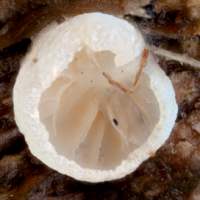Crepidotus cesatii (Rabh.) Sacc. - Roundspored Oysterling
Phylum: Basidiomycota - Class: Agaricomycetes - Order: Agaricales - Family: Inocybaceae
Distribution - Taxonomic History - Etymology - Culinary Notes - Identification - Reference Sources

Crepidotus cesatii is a tiny, kidney-shaped fungus that appears on rotting hardwood in autumn and winter. The attachment is virtually always sessile (having no stem).
Distribution
Common in woodlands throughout Britain and Ireland, this mushroom occurs across mainland Europe and is also recorded in many other parts of the world including North America.
Taxonomic history
The Roundspored Oysterling was described in 18?? by German mycologist Gottlob Ludwig Rabenhorst (1806 - 1881), who established its basionym when he gave it the binomial scientific name Agaricus cesatii. It was Italian mycologist Pier Andrea Saccardo who, in 18??, transferred this species to the genus Crepidotus, whereupon it acquired its currently accepted scientific name Crepidotus cesatii.
Synonyms of Crepidotus cesatii include Agaricus cesatii Rabenh., and ???.
Etymology
The generic name Crepidotus comes from crepid- meaning a base, such as a shoe or a slipper (although some sources state that it means 'cracked'), and -otus, meaning an ear - hence it suggests a 'slipper-like ear'. In the past mushrooms in this genus were sometimes referred to as slipper mushrooms. The specific epithet cesatii honours the Italian botanist Vincenzo de Cesati (1806 - 1883).
Identification guide
 |
CapTypically 0.5 to 2cm in diameter, shell shaped to kidney shaped and often with a slightly scalloped margin, the cap is initially white, turning creamy-ochre with age; laterally attached to its substrate - usually small twigs or branches among leaf litter - via its cap, rather than with a stipe. Infertile surface smooth to finely downy.
|
 |
GillsThe gills, which radiate from the point of attachment, are widely spaced; some gills forking. White at first, they gradually turn pinkish brown or dingy yellowish-pink. Basidia 4-spored. StemAlmost invariably this little woodland mushroom has no stipe (stem) at all. |
SporesSubglobose, ornamented with minute spiny warts, 6.5-8.5 x 5-7µm. Spore printPinkish buff. |
|
Odour/taste |
Not distinctive. |
Habitat & Ecological role |
Saprobic, on rotting fallen twigs and branches in deciduous and sometimes coniferous woodlands and at the bases of hedgerows. |
Season |
August to December in Britain and Ireland. |
Similar species |
Crepidotus variabilis is macroscopically similar but has elongated oval spores. |
Culinary Notes
This common summer and autumn species is of dubious edibility and of no culinary interest.
Many authorities give this genus family status as Crepidotaceae, while others include the genus Crepidotus within the family Inocybaceae; this should be a warning that these little fungi are not for eating, as some Inocybe species are deadly poisonous. Care is needed, therefore, when collecting edible Oyster Mushrooms, Pleurotus ostreatus, to avoid accidentally gathering Roundspored Oysterlings instead.
The pinkish buff spore print of a Roundspored Oysterling (and in most instances its much smaller size) distinguishes it from edible Oyster Mushrooms, whose spore prints are not pinkish buff but white.
Reference Sources
Fascinated by Fungi, 2nd Edition, Pat O'Reilly 2016, reprinted by Coch-y-bonddu Books in 2022.
British Mycological Society. English Names for Fungi.
Dictionary of the Fungi; Paul M. Kirk, Paul F. Cannon, David W. Minter and J. A. Stalpers; CABI, 2008
Taxonomic history and synonym information on these pages is drawn from many sources but in particular from the British Mycological Society's GB Checklist of Fungi.
Acknowledgements
This page includes pictures kindly contributed by David Kelly.
Fascinated by Fungi. Back by popular demand, Pat O'Reilly's best-selling 450-page hardback book is available now. The latest second edition was republished with a sparkling new cover design in September 2022 by Coch-y-Bonddu Books. Full details and copies are available from the publisher's online bookshop...

